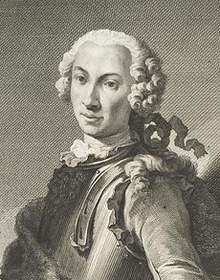Loading AI tools
From Wikipedia, the free encyclopedia
Frederic Louis Norden (22 October 1708 – 22 September 1742) was a Danish naval captain, cartographer, and archaeological explorer. Also known as Frederick, Frederik, Friderick, Ludwig, Ludvig and Lewis, names used on the publications of his famous Voyage d'Egypte et de Nubie. [1][2]
Frederik Ludvig Norden | |
|---|---|
 Frederic Louis Norden, from Voyage d'Egypte et de Nubie, 1755 | |
| Born | 22 October 1708 |
| Died | 22 September 1742 (aged 33) Paris, France |
Norden was born in Holstein-Glückstadt. He entered the Royal Danish Naval Academy at Copenhagen in 1722. He was sent on a study mission abroad in 1732. Norden made a voyage through Egypt all the way down to Sudan in 1737–1738. At the request of King Christian VI of Denmark, he was to enter into a trade agreement with Ethiopia on behalf of Denmark. Norden made abundant notes, observations and drawings of everything around him, including people, pharaonic monuments, architecture, installations and maps.[3]
On 8 January 1741 he became a Fellow of the Royal Society of London (registered as Frederic Lewis Norden). He died of tuberculosis the following year in Paris. Norden had prepared the publication of his travel notes all of which were published in the posthumous Voyage d'Egypte et de Nubie (Copenhagen, 1755). Carl Marcus Tuscher (1705–1751) from Nuremberg made the drawings into copperplates for the publication. In 1757 an English edition was published, in 1779 a German edition and in 1795 a French edition.[3][4]
Seamless Wikipedia browsing. On steroids.
Every time you click a link to Wikipedia, Wiktionary or Wikiquote in your browser's search results, it will show the modern Wikiwand interface.
Wikiwand extension is a five stars, simple, with minimum permission required to keep your browsing private, safe and transparent.